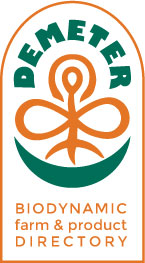“Healing people and the planet through agriculture”
Notes from the Marketplace Archives
TRUTH IN LABELING
or
“When I use a word… it means just what I choose it to mean--- neither more nor less.”
Humpty Dumpty to Alice, Through the Looking Glass, Chapter 6
Any parent of a teenager is well familiar with the array of personal care products cluttering up their shower stalls, medicine cabinets, and bedroom vanities. Of course, my fifteen year old is no different. She does have a mother who, like most of us, is very concerned about the quality of products she is putting in her body as well as ON her body. Last week she came home with her newest drug store purchase- Head Organics™ Shampoo- proclaiming, “Isn’t this great mom? Organic shampoo? You must be very happy with my choice of this super-pure and good-for-the-environment product!” Well, what seemed like a great purchase to her turned out to be a perfect example of Alice’s rabbit hole when it comes to personal care products and how they are labeled. In other words- what a product means when it calls itself “organic” might be entirely different than what you think it means.
Let’s start this story back in the 1990’s, when lots of “organic” products starting showing up on grocery store shelves based on a multiplicity of standards, causing consumer confusion and undermining confidence in the integrity of the claims. In response, the USDA, through an act of Congress, authorized the National Organic Program (NOP) to define what was required in order for a product to be labeled “organic,” and began to uniformly apply those requirements through a federal regulatory process. As of 2002, it was illegal for anyone to use the word “organic” on a product, whether claiming it as certified or not, if it did not meet those minimum standards for organic production.
But here is where it gets interesting: the product scope of the NOP includes foods ranging from canned to fresh produce, meats, poultry, baked goods, and beverages.  It does not extend to personal care products like shampoos, lotions, or cosmetics.   What that practically means is that while an apple or a frozen pizza has to BE organic to be called organic, shampoo does not. The USDA does allow personal care products to be certified organic, BUT it doesn’t require certification on a product labeling organic unless the product actually makes a certified claim.
Manufacturing a certified organic personal care product is not easy. Unlike applesauce or cereal, there are lots of nasty things personal care product manufacturers have been using, including synthetic and petrochemical compounds, many of which are toxic and thoroughly bad for you. When it comes to certified organic products: products labeled as “100 percent organic” must contain only organic ingredients (excluding water and salt). These products may display the USDA Organic Seal. Products labeled as “Organic” must contain at least 95 percent organic ingredients, there are parameters for the remaining 5 percent, and they may also display the USDA seal. Products labeled “Made with organic ingredients” require 70 percent organic ingredients, but may not display the seal, for fear of misleading consumers into thinking that the product itself is organic. Products with less than 70 percent organic ingredients cannot use the term “organic” anywhere on the principal display panel, however they may identify the specific ingredients that are USDA-certified on the ingredient panel.
Getting back to my daughter’s Head Organics™ Shampoo- while there are 5 certified organic ingredients listed on the ingredient panel (that is 5 of the smallest quantity ingredients out of a list of 20) the word “organic” shows up eight more times on the product packaging including IN THE COMPANY’S NAME! Even more distressing, other ingredients include Sodium Lauryl Sulfocetate (a synthetic that can cause eye irritations, skin rashes and allergic reactions), Cocamidopropyl Betaine (a synthetic surfactant known as an immune system toxicant), Cocamidopropyl Hydroxysultaine (a synthetic antistatic agent that has yet to be assessed for safety in cosmetics), Phenoxyethanol (a synthetic fragrance and preservative that has been restricted in Japan for use in cosmetics because of evidence of skin and immune system toxicity), and Ethylhexylglycerin (which can cause eye toxicity and is classified as an irritant).
For heaven’s sake!  What’s a mother to do? Well, moms aren’t the only ones who are outraged at this deception and very concerned for the welfare of their family’s health. The Organic Consumers Association Coming Clean Campaign, with lots of encouragement from Dr. Bronner’s and other reputable organic personal care product companies, have been working to clean up this mess by forcing personal care manufacturers to meet the USDA organic standards in order to label their products as organic. As of June 2011 Whole Foods launched an Organic Body Care Standards policy that requires its body care companies labeling organic to either meet the USDA standard, or get off their shelves. They wisely pointed out that it is common sense to assume that the definition of “organic” should not change between the food and non-food aisles of stores. Whole Foods' new policy mandates that "Organic" or "Made with Organic Ingredients " claims must be certified under the NOP just like food. Brands that make organic claims that are not certified, including "Organics" in a company’s branding (like Head Organics™), will not be allowed in the stores.
Thank goodness! The folks here at Demeter want you to know that unlike the NOP, which has one standard applied across all product types, the Demeter Biodynamic® Processing Standard has fourteen standard categories, one for each product type including personal care. Personal care, like every processed product category, requires significant and verifiable Biodynamic ingredients for the protection of consumers. A minimum of 70 percent of TOTAL ingredients are required to label “made with Biodynamic® ingredients” and 90 percent to label as “Biodynamic lotion” on the products’ packaging. If a product doesn’t meet the 70 percent threshold, it may reference its Biodynamic ingredients on the ingredient panel if it is certified to another approved organic/natural personal care standard like certified organic.
What does my daughter think about all of this? Well, when we sat down and talked about it, and really scrutinized Head Organics™ Shampoo ingredient list, her only comment was: “Ewwwww mom that’s gross! Never buying that stuff again!”
Couldn’t have summed it up better myself.
For more information:
A great website to check out the ingredients in your products is the Skin Deep® Cosmetics Database at: http://www.ewg.org/skindeep/
Another great resource is The Campaign for Safe Cosmetics at: http://www.safecosmetics.org/
And watch this fun little video “The Story of Cosmetics” with your kids, brought to you by the Organic Consumers Association: http://www.organicconsumers.org/bodycare/index.cfm
“When it comes to purity at the cosmetics counter, organic is taking a back seat to a green standard so pure it’s practically virginal. Biodynamic, a system of natural farming conceived in the Twenties, is quickly gaining a following as many brands up the ante in the battle for the eco-conscious consumer’s carbon footprint-free cash.”Â
 WWD Beauty Biz, “How Does Your Garden Grow”, Megan McIntyre March 2008
---------------------
Previous Articles




